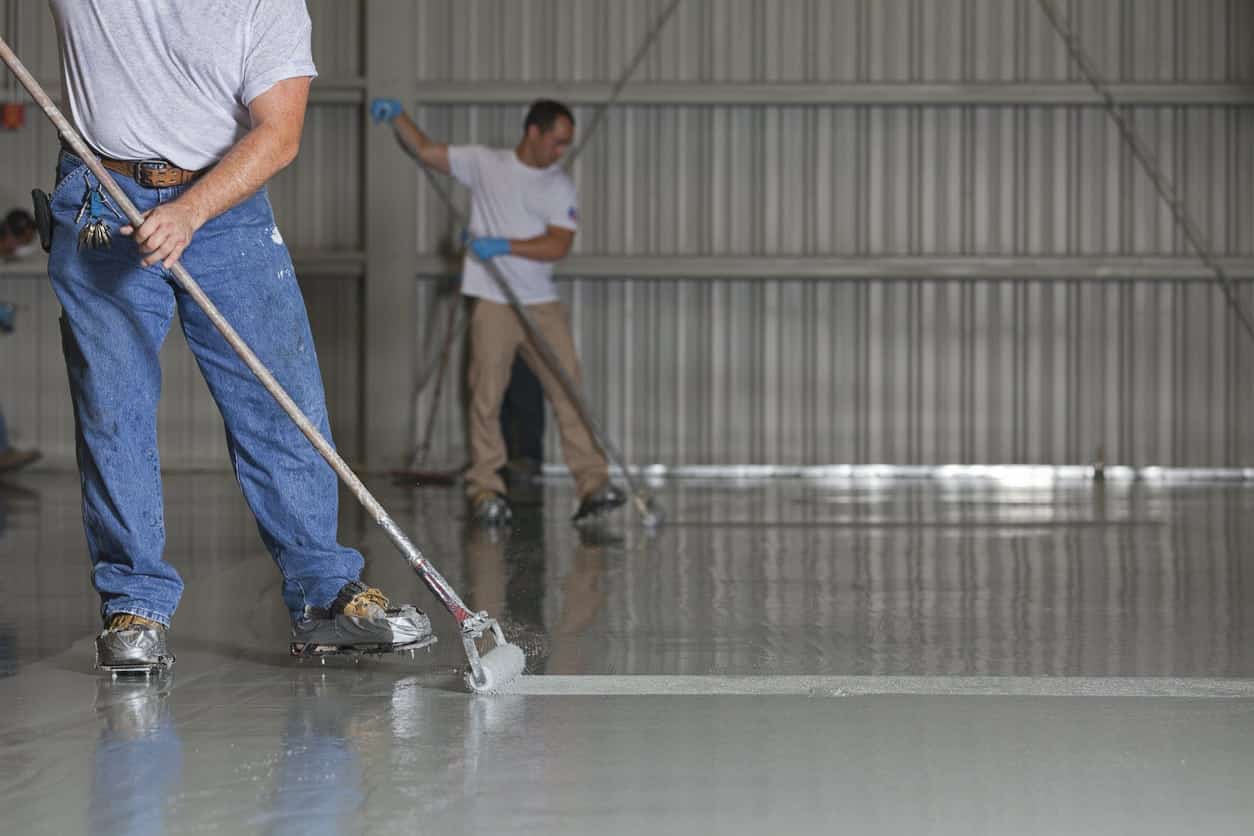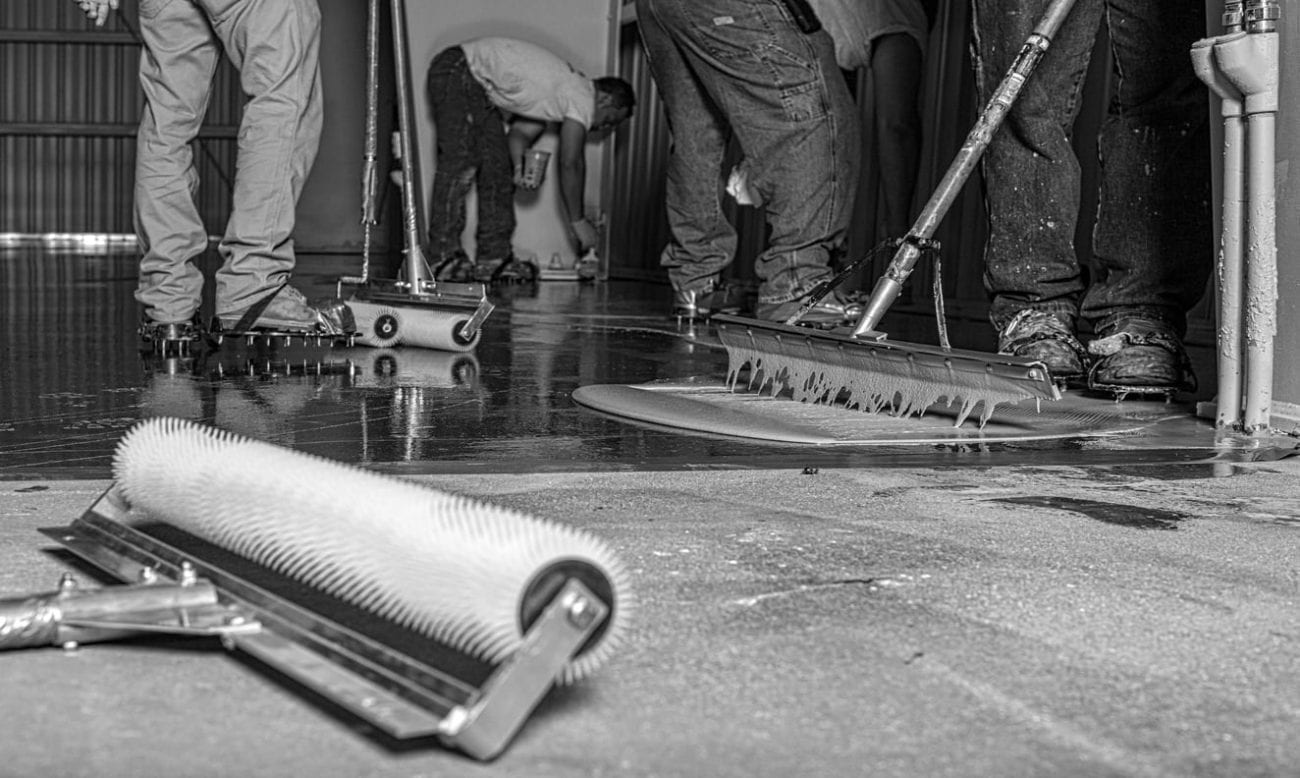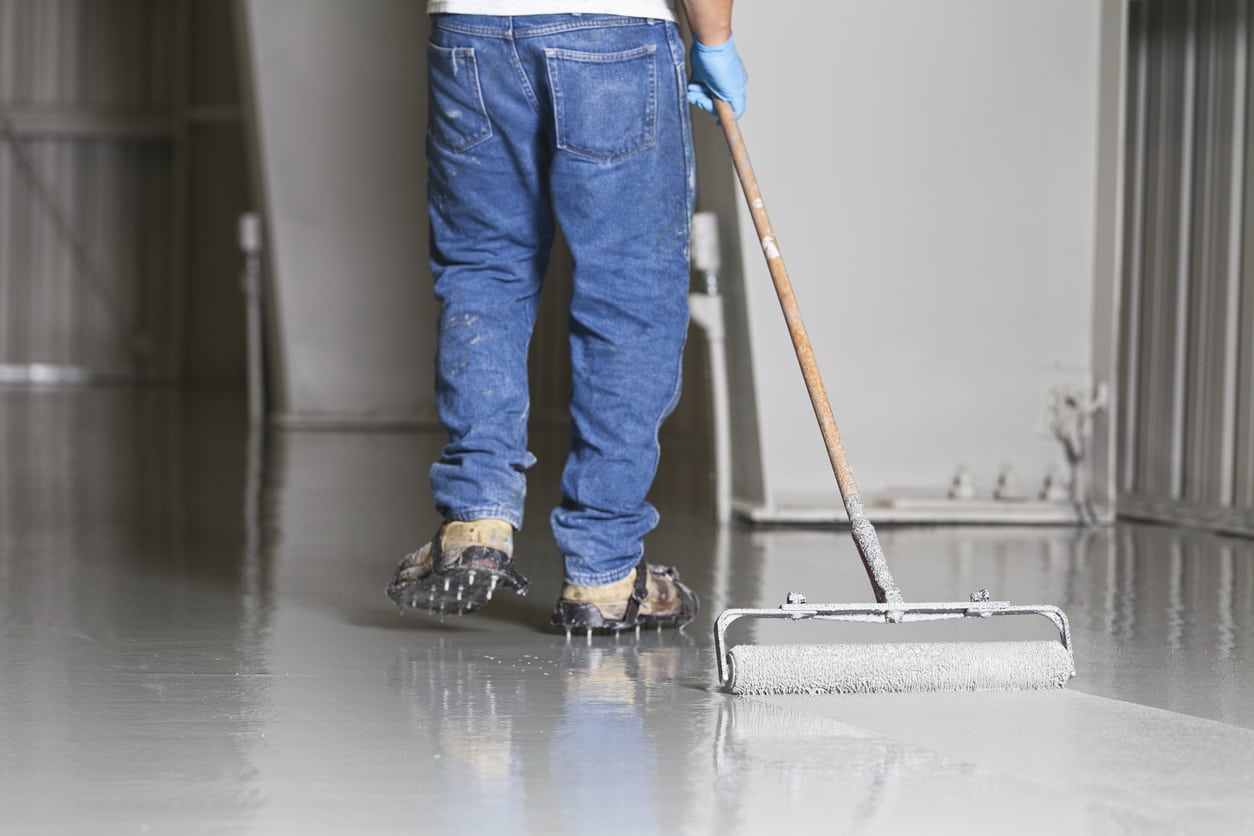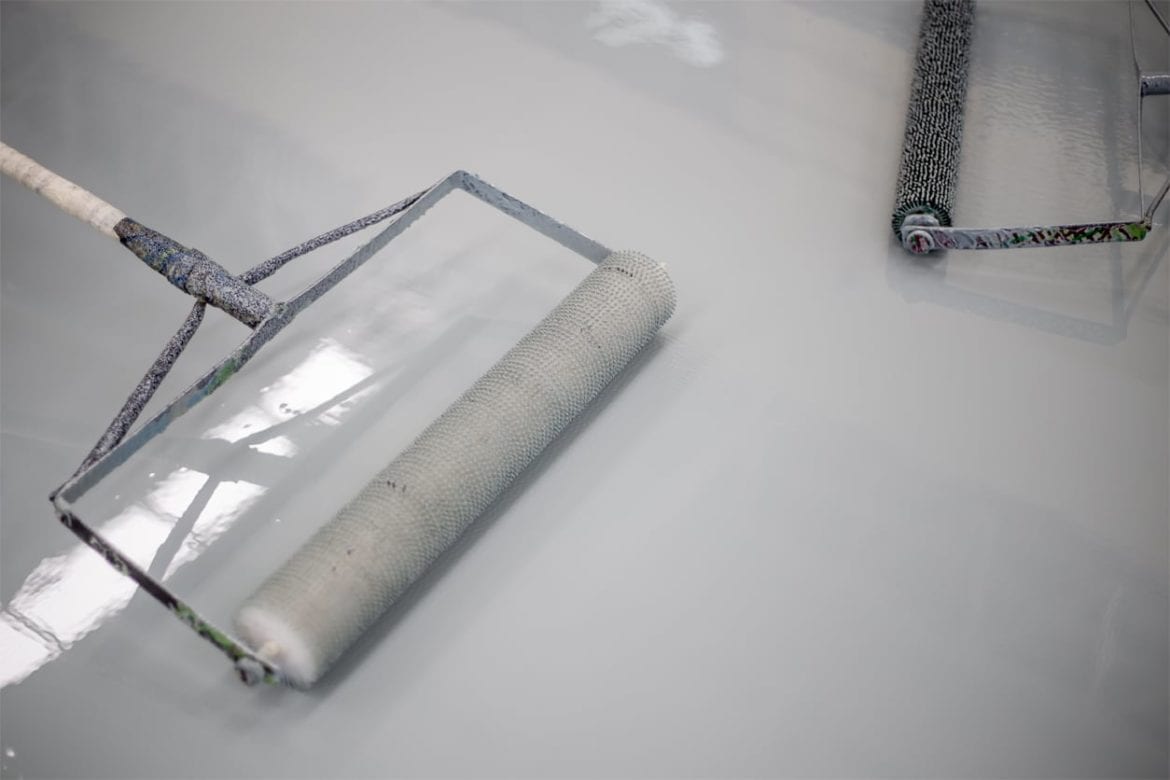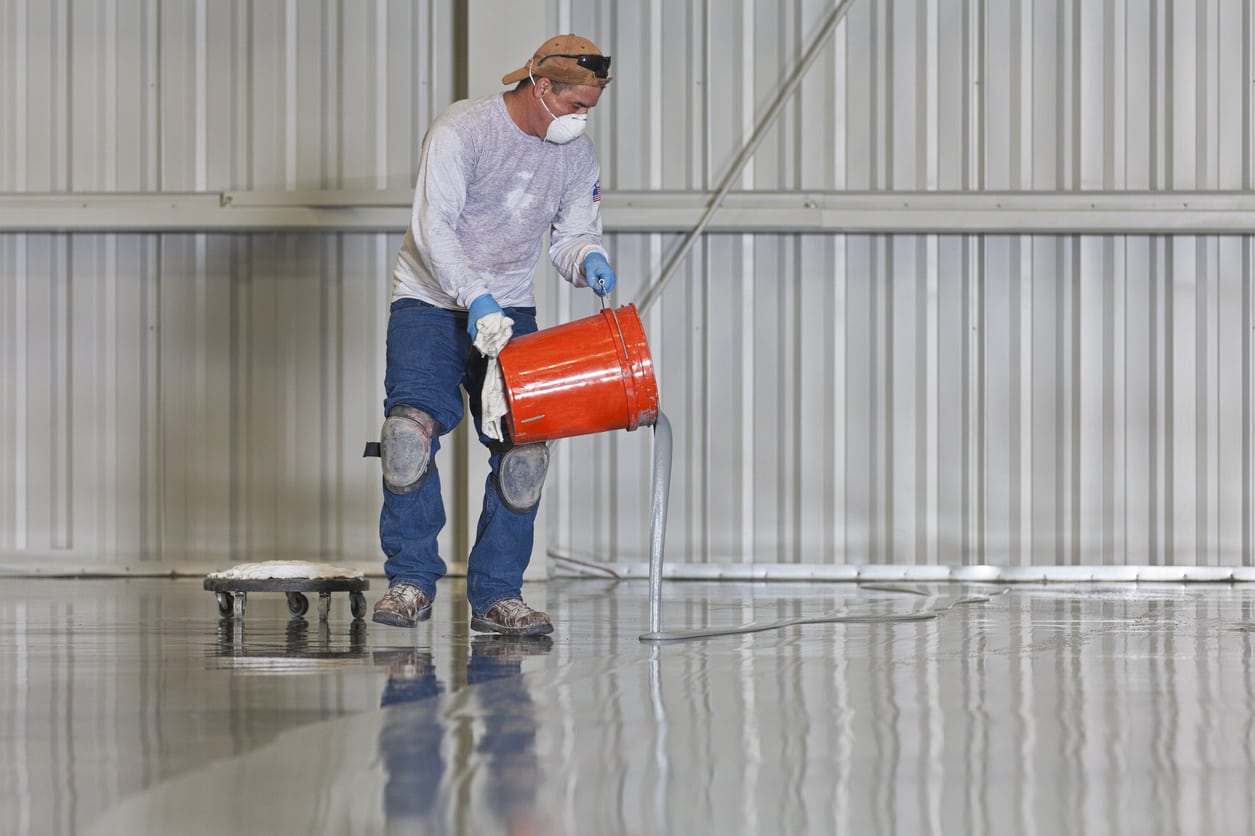Concrete coatings are usually classified as epoxies, urethanes and polyaspartics. A coating differs from a sealer since it is applied on top of concrete creating a glossy build coat finish vs. a sealer that will penetrate and keep a natural finish. Coatings excellent choices for concrete with the need for chemical resistance, acid resistance and abrasion resistance. Although they are labor intensive the finish results can last up to 10 years.
Most Important Features When Purchasing a Concrete Coatings:
- Look for an industrial grade coating with excellent chemical resistance, abrasion resistance, stain and acid resistance.
- Resistance to hot tire pickup, UV rays, heavy equipment / machinery and extreme temperature is a must.
- Look for durable coatings that will not peel, flake or delaminate (usually aliphatic and/or cyclo-aliphatic urethanes, polyaspartics and epoxies)
Most Popular Concrete Coatings Brand Reviews:
Urethane 645: Meets all of the above criteria while also providing excellent dust protection and hardness. High solids coatings with exceptional chemical and acid resistance properties. We found that it was more durable and scratch resistant than all the other urethanes we tested all while creating a beautiful gloss shine. Easier to apply than it sounds while being practically indestructible.
One Day Floors 100%: Polyaspartic coating, fast drying and excellent penetration and bond strength to properly prepared surfaces and are abrasion, impact, and wear resistant with flexible properties. Not as chemically resistant as a urethane coating and the floor must have a minimum surface porosity of a CSP-2.
APF Armor-Rez Jet Deck 200: Three coat high build system that is extremely labor intensive consisting of an epoxy primer, epoxy coating and polyurethane topcoat. Excellent compressive strength and an extreme high build finish; however this product is not extremely UV stable.
When it comes to garages and warehouses they require a tougher, durable, chemically resistant coating. Urethanes, especially aliphatic urethanes, are stronger, more chemically resistant, UV resistant and have a higher abrasion resistance. If you have an industrial warehouse and you decide that you need to seal it you have two options: a concrete densifier or a urethane coating. Concrete densifiers are excellent choices if you need to harden, dust-proof and increase the abrasion resistance of a warehouse. However if you need extra chemical resistance you need an aliphatic urethane coating.
Urethanes are easy to apply and can last up to ten years if you follow all of the proper precautions and instructions. The first step you need to take when applying an aliphatic urethane is to grind the existing concrete surface. By grinding the concrete you are creating a tougher surface for the products to adhere to so it will not scratch or peel after application. After grinding the concrete you need to mix Part A components to Part B components and apply using a squeegee. By using the squeegee you can elongate the coverage and it allows for the proper mil coverage. After squeegeeing you need to back roll the surface and then let the Urethane dry for 3-5 days to completely set.
Our Take: Urethane coatings that have held up the best for the longest time period are Urethane 645, Superior Industries Aliphatic Urethane , and APF’s Polyurethane 250 High Performance Concrete Sealer.
Urethanes and polyaspartics are topcoating concrete sealers that are specially designed to adhere and bond to the surface of concrete slabs. Once properly applied to the surface, the sealers offer incredible levels of protection, leading to them often being referred to as the miracle concrete sealers. They both offer extensive heat resistance, comprehensive scratch resistance, resistance to abrasions and high foot traffic, as well as prevention of acid and chemical stains.
Due to their plethora of preventative and protective properties, urethanes and polyaspartics are typically in high demand for industrial warehouses and large retail stores, namely places that feature high levels of foot traffic or potentially damaging activity (such as lifting bales of product or driving with a forklift over the concrete). Urethanes and polyaspartics work to protect the concrete underneath from any and all types of damage.
They also, however, work best as part of epoxy floor systems. Epoxy floor systems are typically layers of concrete sealer that are applied one after another to increase the protection offered to your concrete floors. Most systems consist of an epoxy basecoat that is meant to adhere directly on the concrete substrate’s surface, followed by another epoxy coating to increase resistance to various problems. Now, after the first two epoxy coatings, many people choose to install a decorative, aesthetic piece by sprinkling in paint chips or decorative quartz (which is really just sand) onto the second epoxy coating. With this completed, the urethane or polyaspartic topcoat is applied to provide maximum, translucent protection.
The biggest, and really only, difference between urethanes and polyaspartics is a big one. Polyaspartics tend to be slightly more expensive because they have an exceptionally fast dry-time. No, really, it is quite exceptional. Polyaspartics tend to be the topcoating of choice for large retail stores that need to be open the next day: simply apply the polyaspartic coating overnight, and it will be completely dry in only a few hours. When compared to urethanes, the benefits and coverage are the same, by the dry-time is exceptionally different.
Our Take: The best urethane we have found is an aliphatic urethane Urethane 645 while a fast drying polyaspartic is Polyaspartic 745.
Epoxies, urethanes, and polyaspartics are all very similar types of concrete sealers. They are all surface sealers, meant to be spread evenly over the surface of a concrete slab, protecting it from all sorts of damage without penetrating past the surface. They are all also typically two-component polymers (though there are one-component products out there), meaning they have to be mixed prior to application.
Epoxies, urethanes, and polyaspartics are best suited for high traffic areas, such as the floors of large retail stores, industrial complexes, warehouses, and airports. All of these are examples of buildings whose floors are at a high risk of chemical spillage, abrasion, and other types of potential damage. The three types of sealer are all extremely tough and durable, making them all great choices.
The biggest difference comes with their chemical compositions. Epoxies are a little stronger than urethanes and polyaspartics, making them great basecoats and standalone layers. They bond extremely well to rough concrete surfaces, and they have a wide variety of features making them great for bottom layers. Urethanes can be applied as standalone products, but they are not meant for surfaces that are as rough. Polyaspartics are simply a type of urethane, typically aliphatic urethanes. They provide the same level of protection, but they also have the added bonus of drying incredibly fast. This quality makes them well suited to projects in retail stores or buildings that need to be open and functioning the next day.
All three of the products are strong and similar, but they also all work best as part of an epoxy system. Epoxy systems are simply the combination of one or two epoxy basecoats, followed by a urethane or polyaspartic topcoat, depending on your particular project. You can even add some sort of decorative touch to the project, such as adding sand or paint chips after the epoxy basecoats but before the urethane or polyaspartic topcoat. When applying an epoxy system, you must wait for each layer to dry completely before adding additional layers. If you want the best, strongest, and longest lasting results, you should elect to use an epoxy floor system, as this will ensure your concrete remains visually and structurally sound for years to come.
Polyaspartic sealers are a relatively new phenomenon that are increasingly becoming more popular as part of epoxy floor systems. However, they are also standalone products that may be the perfect choice for your particular concrete project. While acrylic sealers are great for decorative concrete and penetrating sealers are perfect for surfaces like basement floors that need deep protection, polyaspartics are slightly different.
Polyaspartic sealers are a surface level sealer, like acrylics and epoxies. Rather than penetrate into the concrete, they will remain on the surface to be applied comprehensively to cover the concrete surfaces they are meant to protect. They tend to be solvent-based, rather than water-based, providing thorough and lasting protection.
Polyaspartics are technically a type of urethane sealers. Urethanes, such as aliphatic urethanes, tend to be one- or two-component polymers that have varying solids contents. This means they are a perfect choice for floors and other concrete surfaces with high traffic and risk of abrasions, scratches, and spills. Polyaspartics feature excellent hardness and abrasion resistance, all while repelling chemical and moisture stains.
Polyaspartics are fast becoming recognized as a miracle material. They demonstrate excellent flexibility, able to bridge small cracks and protect already cracked surfaces. Similarly, they can be applied at almost any temperature, always featuring incredible bond strength to the concrete substrate. They are long-lasting, clear, and they can easily be applied over an epoxy basecoat or a number of epoxy basecoats.
The best quality polyaspartics possess, however, is its incredibly fast tack-free dry time. Drying in as little as one hour, depending on the particular conditions of each project, polyaspartics are the best choice for retail stores, industrial warehouses, business parks, and other places whose concrete is in need of help. Simply apply the polyaspartic coating overnight, and the floor will be dry and ready to use by the morning. The high level of protection afforded by polyaspartics, in conjunction with their exceptionally fast dry time, make them an ideal choice for many concrete sealing situations.
Our Take: One of the best polyaspartics is Polyaspartic 745 with a super fast dry time of 1-3 hours
What is a urethane concrete sealer and what is the best urethane concrete sealer? Urethane concrete sealers are the most durable but they can also be the most expensive solutions. We find them to be highly scratch, abrasion and chemically resistant topical sealers that have the longest life cycle before reapplication compared to an acrylic or epoxy. Urethane sealers are also available in water and solvent based versions. Unlike epoxies they can be used on both interior and exterior surfaces since they are clear and non-yellowing. Urethanes do not allow moisture to travel through the concrete and they are not very breathable so we do not recommend them for sealing driveways. Please note that urethanes do not bond well to concrete so it if not ideal to apply a urethane to an existing concrete floor. Instead we recommend using an epoxy as a primer and then use a urethane as a top coat especially because urethanes are UV resistant. Commonly used in industrial settings like the food and beverage industry urethane coatings are usually high gloss and they retain their gloss very well over time.
Our Take : Best Urethane Concrete Sealers
Urethanes are tricky to apply and dependent on surface preparation. Some of the top urethane based sealers include Urethane 645 and an alternative to that is APF’s Polyurethane 250 High Performance Concrete Sealer
Recommended For:
High traffic area floors. Urethane provide excellent protection for floors with heavy traffic and vehicle traffic because of exceptional abrasion and chemical resistance properties.
Stamped or decorative concrete: Urethane’s will bring out details and colors when applied to decorative concrete.
Interior Concrete Floors: Since urethanes are abrasion and chemically resistant they are ideal for hopsitals, pharmaceutical facilities and supermarkets.


